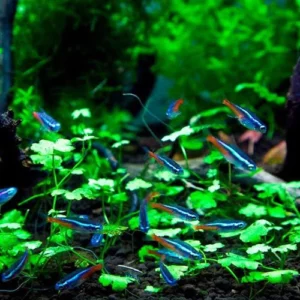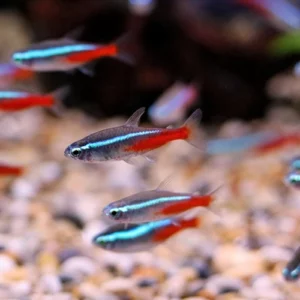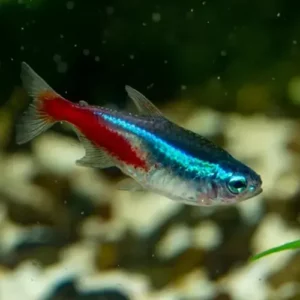Can Guppies And Neon Tetra Live Together? Yes And How
Yes, guppies and Neon Tetras can cohabitate in the same aquarium. Both species exhibit generally peaceful behaviors, making them compatible tankmates. They thrive in similar water parameter requirements, with overlapping preferences for temperature, pH, and water hardness. Additionally, they occupy different areas of the tank, with guppies often swimming in the upper parts while Neon Tetras prefer the middle. However, care must be taken during feeding times to prevent competition and when guppies breed, as their fry might be at risk around the Neon Tetras. Proper tank setup, including ample hiding spots and maintaining optimal water conditions, is crucial for their harmonious coexistence.
Home » Guides » Fish Care » Neon Tetra » Can Guppies And Neon Tetra Live Together? Yes And How
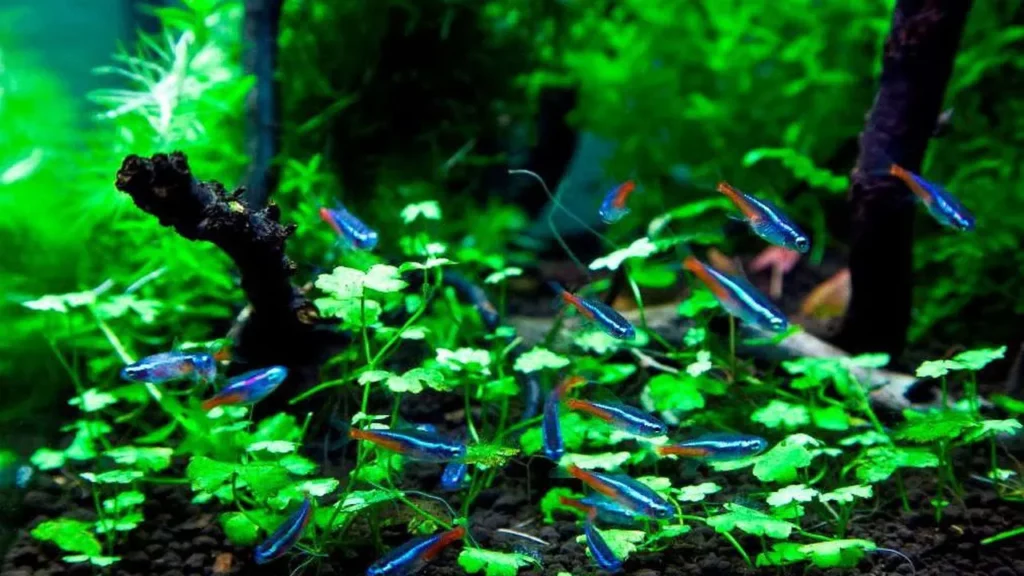
|
|
|
|
|
|
|
|
Neon Tetra Fact Sheet
| Scientific Name | Paracheirodon innesi |
| Common Name | Neon Tetra, Neons |
| Care Difficulty | Easy |
| Life Expectancy | 3-10 Years |
| Average Size | 1.5 Inches (3.8cm) |
| Temperature | 72°F – 82°F (22°C -28°C) |
| Diet | Omnivore |
| Behavior | Friendly/Peaceful |
| Breeding | Medium/Hard |
| pH | 6-7.5 |
| Live Plant Friendly | Yes |
Basic Behavioral Traits of Both Fish
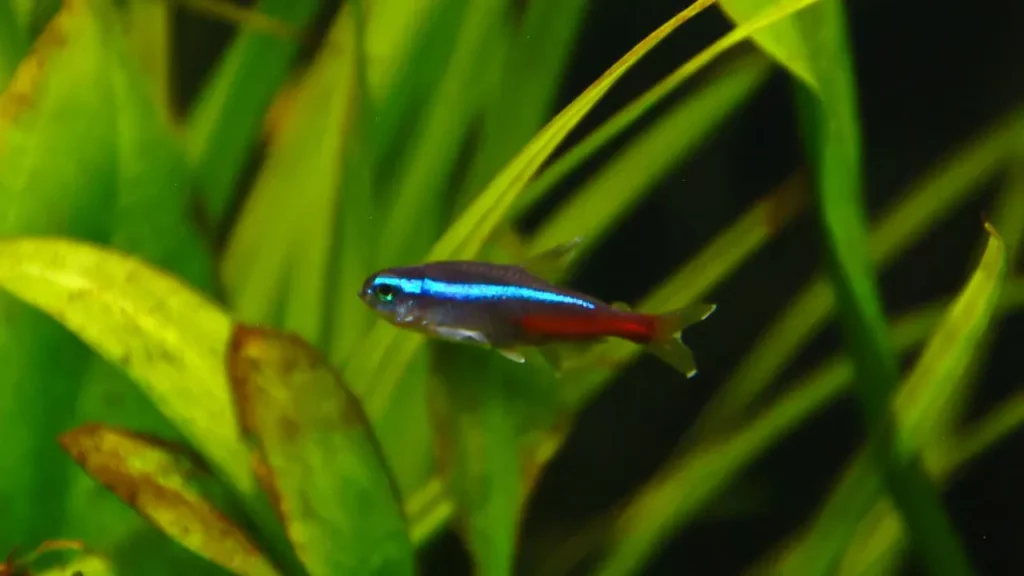
Guppies
The guppy (Poecilia reticulata) is often seen as the cheerful, vibrant addition to many freshwater aquariums. They come in a dazzling array of colors and patterns, but beyond their beautiful appearance, guppies are treasured for their lively personalities.
Active and Playful Nature: Picture a playful puppy, but aquatic. Guppies are often on the move, showing off their colorful tails and fins as they glide, turn, and play in the water. They have a curious nature, which means they’ll often be seen exploring every nook and cranny of their tank. As an observer, you can spend hours being mesmerized by their spirited antics.
Compatibility with Peaceful Tankmates: Here’s where the guppy truly shines. Their gentle disposition means that they usually get along well with other peace-loving fish. They’re not known for being nippy or aggressive, making them a favorite choice for community tanks. In their natural habitat, guppies are often found in calm waters, living harmoniously with a variety of species. This social nature translates well into captivity, where they often coexist with other peaceful fish without much fuss.
However, one word of caution: Their flamboyant tails can sometimes be tempting for fin-nipping species, so always ensure that their tankmates are of similar peaceful temperament.
Neon Tetras
The Neon Tetra (Paracheirodon innesi) is a petite fish, yet its vibrant colors make it an unmistakable star in many freshwater aquariums. They’re like little streaks of lightning, illuminating the watery depths with their iridescent glow.
Schooling Behavior: Unlike our independent guppy friends, Neon Tetras are all about community and teamwork. In the wild, they form schools, a behavior they retain in captivity. This schooling isn’t just for show. It’s a survival mechanism that offers protection from predators and a sense of security. Watching a school of Neon Tetras moving in synchrony is a breathtaking sight – it’s like witnessing an underwater ballet. For those wishing to keep these beauties, it’s advisable to have a group of at least 6 to 10 to allow them to exhibit this natural behavior.
Generally Peaceful Demeanor: Neon Tetras, with their serene and calm nature, often prefer life without confrontations. They’re not the bullies of the tank, far from it. However, their small size means they can be vulnerable to larger, aggressive fish. Hence, they’re happiest when surrounded by fellow peace-loving species. That said, their calm nature shouldn’t be mistaken for timidity. These little ones have a zest for life and a curious nature, making them engaging tank residents.
Reasons for Compatibility
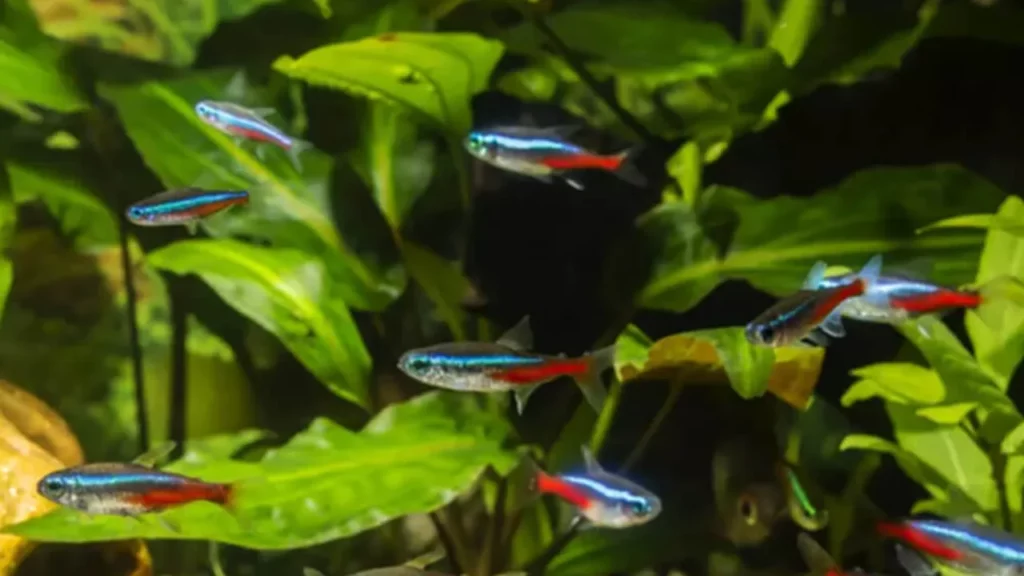
Similar Water Parameter Requirements
Both guppies and Neon Tetras originate from tropical regions, which means they have some overlapping preferences in their aquatic environment.
Temperature: Guppies thrive in temperatures ranging from 72°F to 82°F (22°C to 28°C). Neon Tetras, coming from the warm waters of the Amazon, prefer temperatures slightly on the warmer side, between 70°F and 81°F (21°C to 27°C). You’ll notice that there’s a lovely overlap here, making it easy to set a comfortable middle ground, say around 75°F (24°C), where both species can thrive.
pH Levels: The pH level of water is a measure of its acidity or alkalinity. Guppies are quite versatile and can manage in a pH range of 6.8 to 7.8. Neon Tetras naturally come from soft, acidic waters of the Amazon and prefer pH levels between 6.0 and 7.0. This means setting your tank’s pH around 6.8 to 7.0 can be an ideal middle ground.
Water Hardness: Water hardness, often measured in dGH, refers to the concentration of minerals, particularly calcium and magnesium. Guppies, with their hardy nature, can tolerate a range of hardness levels, from soft to hard. Neon Tetras, on the other hand, have a preference for soft to moderately hard water. By maintaining a balanced hardness level, you can ensure both species feel right at home.
Non-aggressive Nature
Peaceful coexistence in a tank depends largely on ensuring its residents have a gentle disposition. And lucky for us, both guppies and Neon Tetras tend to avoid confrontations.
Guppies: These vibrant little fish are sociable and usually non-aggressive. They prefer frolicking with their kind and exploring their environment. However, they aren’t entirely free from squabbles, especially when males compete for the attention of females. But, in general, these minor disputes seldom escalate into harmful behaviors. They’re like friendly neighbors who occasionally have a playful argument over who has the more vibrant tail.
Neon Tetras: Neon Tetras are generally calm and non-confrontational. Their main defense mechanism in the wild is their schooling behavior, where there’s safety in numbers. In a tank, while they do have their playful chases within the school, they tend to avoid causing trouble with other species. They’re the polite members of the tank community, preferring to keep their heads down and shine on.
When you house these two species together, their mutual non-aggressive tendencies mean they’re more inclined to live and let live. There’s no territorial conquest or power struggle. It’s like pairing two gentle souls who prefer harmony and beauty over conflicts.
Different Areas of Tank Occupation
When setting up a community tank, understanding the preferred swimming zones of each species can play a crucial role in ensuring harmony. And here, nature has orchestrated a delightful dance between our two protagonists.
Guppies: Think of guppies as the residents of the penthouse suite. They are surface dwellers and primarily stay in the upper parts of the tank. This is where they come up to take gulps of air, owing to their labyrinth organ, and also where they often play and display their vibrant colors. Their predilection for the top gives them a bird’s-eye view of the tank’s goings-on.
Neon Tetras: Now, the Neon Tetras are more middle-level enthusiasts. They prefer the mid-section of the aquarium, gracefully darting between plants and other decors. This middle zone offers them both protection and the right vantage point to observe the world above and below. Their brilliant blue and red hues shine particularly well here, often creating a mesmerizing visual spectacle against the green of aquatic plants.
This natural division of tank real estate is rather fortuitous. With guppies enjoying the upper reaches and Neon Tetras claiming the mid-zone, there’s minimal competition for space. It’s like having neighbors who have distinct favorite spots in a shared garden, ensuring everyone has room to stretch, play, and shine.
Potential Challenges in Co-housing
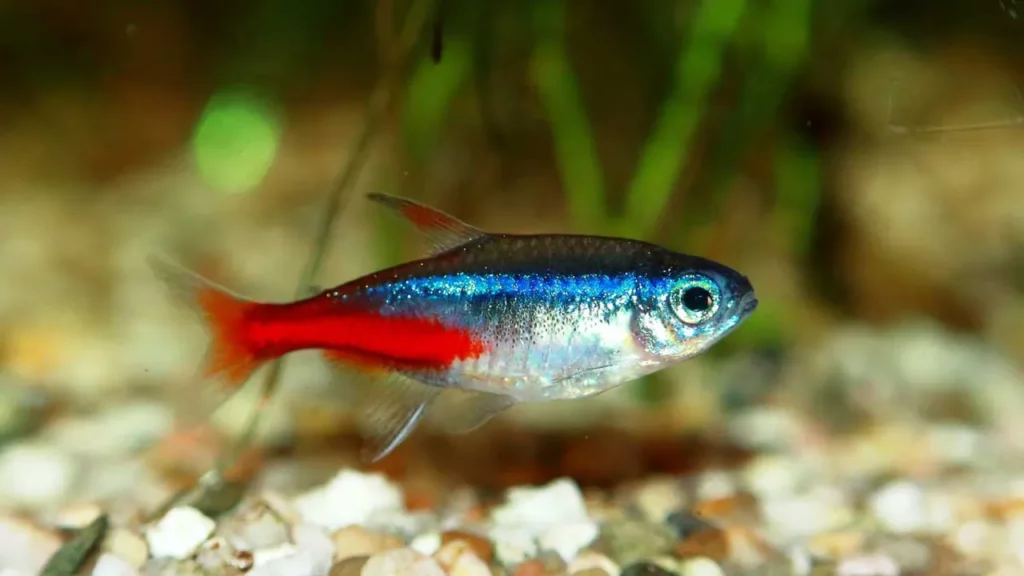
Competition for Food
When the food flakes start to descend from the heavens (or, you know, the hand of a caring aquarist), a little drama can unfold in our underwater theater.
Eager Eaters: Both guppies and Neon Tetras, despite their peaceful demeanors, are quite enthusiastic when it comes to food. Their eagerness can sometimes look like a frenzied dance, as they dart around snatching up the delicious morsels.
The Guppy’s Advantage: Remember how we spoke about guppies preferring the upper levels of the tank? This gives them a bit of a ‘first dibs’ advantage. They’re often the first to reach the floating flakes or pellets, getting their fill before the food even starts its descent.
Neon Tetras and Their Strategy: While the guppies are busy at the top, Neon Tetras, with their mid-level preference, often wait for the food to sink a bit. But here’s the catch: if the guppies are too quick or there isn’t enough food to go around, our shimmering Neon friends might end up with less than they’d prefer.
Balancing the Scales: To ensure both species get their fair share, consider using a mix of floating and sinking foods. This way, while the guppies are occupied at the surface, the Neon Tetras can feast on the sinking granules or pellets. Additionally, spreading the food across different areas of the tank’s surface can help distribute the feeding frenzy and give everyone a fair shot.
Breeding Considerations
When guppies decide it’s time to add some young ones to the mix, things can get both fascinating and a tad complicated, especially with Neon Tetras around.
Guppy Breeding Behavior: Guppies, being livebearers, give birth to fully formed fry rather than laying eggs. It’s a magical moment when the tiny replicas emerge and start their journey. However, these young ones are vulnerable in the initial stages of their life, even in a peaceful community tank.
Neon Tetra’s Curiosity: Neon Tetras are generally peace-loving, but their curious nature can sometimes spell trouble for guppy fry. The tiny, darting movements of the fry can trigger a predatory response in the otherwise peaceful Neon Tetras. It’s not that they’re inherently aggressive, but the allure of a tiny, wriggling snack can be too tempting to resist.
Creating Safe Zones: To ensure the safety of the guppy fry, consider adding dense plantations or breeding grass to your aquarium. These provide natural hideouts for the young ones, allowing them to escape prying eyes and hungry mouths. Floating plants can also offer sanctuary, given the guppies’ preference for the upper levels of the tank.
Alternative Solutions: Some aquarists opt to use separate breeding tanks or partitioned sections to protect the fry until they’re large enough to fend for themselves. This ensures that the delicate balance of the community tank remains undisturbed during the breeding phase.
Individual Temperaments
Fish Personalities: It’s intriguing to think of fish as having personalities, but indeed, they do. Even within the same species, one guppy might be the adventurer, boldly exploring every nook and cranny, while another might be more of a homebody, sticking close to its favorite plant.
Exceptions to the Rule: Generalized behavior patterns, like those we’ve discussed for guppies and Neon Tetras, serve as a guideline. However, there might be that one Neon Tetra that’s a little more nippy than its peers or a guppy with a penchant for chasing its tankmates.
Reasons for Varied Behavior: A multitude of factors can contribute to these individual variances, from genetics to past experiences. For instance, a fish that has had negative encounters in its past might be more skittish or aggressive.
Navigating Individuality: Observing your fish and understanding their individual temperaments is crucial. If a particular fish consistently disrupts the peace of the tank, it might be worth considering relocating it to a more suitable environment where it can thrive without causing undue stress to others.
The Beauty of Diversity: It’s the combination of these unique personalities that adds depth and color to our underwater narrative. Just as a story is made richer by a diverse cast of characters, so too is our aquarium by the myriad temperaments of its inhabitants.
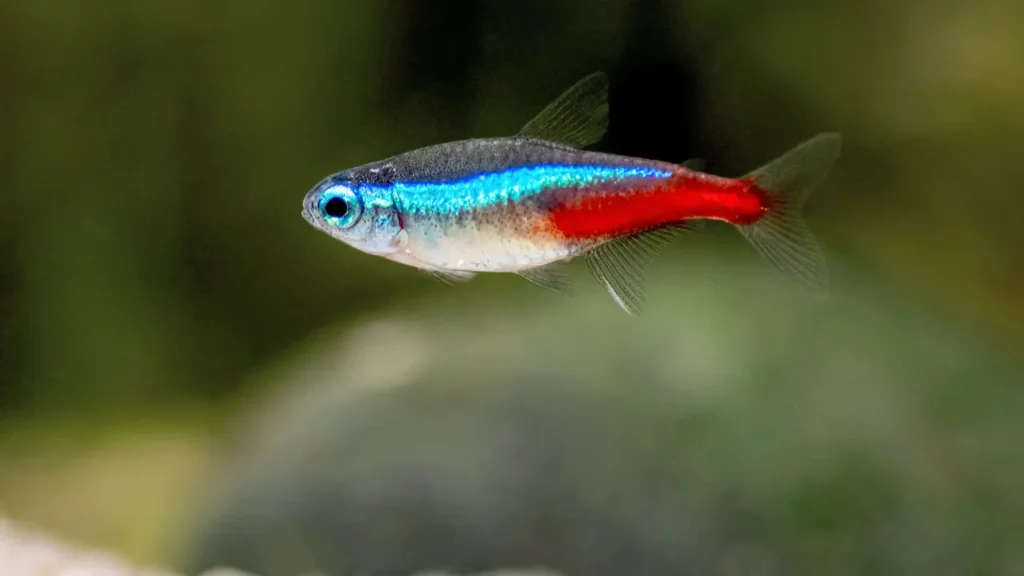
Appropriate Tank Size
Understanding Space Needs: While guppies and Neon Tetras might be small in size, they’re bursting with energy and zest for life. This translates to a need for ample space to swim, explore, and naturally express their behaviors.
Guppies’ Requirement: Guppies, being active swimmers, enjoy the liberty of space. While one might be tempted to house them in small bowls or tiny aquariums, it’s a misconception that they don’t need much room. A spacious environment not only aids in their well-being but allows their vibrant colors and playful antics to truly shine. For a community of guppies, consider starting with a tank of at least 10 gallons.
Neon Tetras’ Domain: Neon Tetras are schooling fish, and their true beauty is unveiled when they swim in groups, mirroring and echoing each other’s movements in a mesmerizing dance. For a comfortable school of Neon Tetras, you’d ideally want a tank that’s at least 20 gallons to allow them the space to school and thrive.
Combining the Two: When co-housing guppies and Neon Tetras, a tank size of at least 20-30 gallons is recommended. This ensures there’s ample room for both species to coexist without feeling cramped, allowing for territories, schooling, and playful chases.
The Bigger Picture: If space and budget allow, always consider going for a larger tank. A bigger canvas not only provides more room for our finned protagonists but also makes the ecosystem more stable. With larger water volumes, any fluctuations in water parameters can be managed more efficiently, ensuring our aquatic tale’s longevity.
Providing Plenty of Hiding Spots
Providing Plenty of Hiding Spots
Creating a multi-dimensional environment in the aquarium isn’t just for aesthetic purposes; it has functional significance for our finned friends.
Nature’s Blueprint: In their natural habitats, both guppies and Neon Tetras utilize plant cover, rocks, and submerged structures as hiding spots and territories. These provide shelter from potential predators, resting areas, and even breeding grounds.
Importance for Guppies: While guppies are often seen frolicking in the open, they too appreciate the occasional nook and cranny. Especially when they are stressed or during breeding times, dense plant cover or cave-like structures can offer the solace they seek.
Neon Tetra’s Retreat: Being a schooling fish doesn’t mean Neon Tetras don’t value privacy. Their shimmering bodies can sometimes attract unwanted attention. Dense plantations or specially designed aquarium decorations can serve as their secret hideaways, allowing them a brief respite from the world outside.
Setting the Stage: Incorporate a mix of live aquatic plants, such as java fern, anubias, or crypts, which not only offer hideouts but also enhance water quality. Rocks, driftwood, and specially designed aquarium caves can further add layers to the underwater landscape, ensuring there’s a balance between open swimming spaces and secluded corners.
A Living Tapestry: Crafting these hiding spots isn’t just about placing objects randomly. It’s an art. Visualize the flow of your underwater world. Think of it as weaving a living tapestry, where every plant, stone, or piece of driftwood contributes to the larger picture while serving our aquatic actors’ functional needs.
Water Conditions and Filtration
In the grand theater of the aquarium, water plays both the stage and the sustainer. It’s not just about filling up the tank; it’s about maintaining a world.
Water Parameters: The quality of water significantly impacts the health and vitality of our aquatic companions. Aspects like temperature, pH, and water hardness are pivotal for both guppies and Neon Tetras. Typically, a temperature range between 72°F to 78°F, a pH of 6.5 to 7.5, and moderate hardness is suitable for both species.
The Role of Filtration: An efficient filtration system is the unsung hero of our narrative. It tirelessly works to:
- Mechanically remove particulate matter, ensuring clarity.
- Biologically break down harmful substances like ammonia and nitrites, thanks to beneficial bacteria.
- Chemically (if using activated carbon or similar media) remove impurities and odors.
Choosing the Right Filter: With myriad filters available, picking the right one might seem like a daunting task. However, the principle is simple: opt for a filter that can circulate the tank’s water volume at least 4-5 times per hour. For our story’s setting, a hang-on-back filter or a canister filter for larger tanks might fit the bill.
Regular Maintenance: Even the best of filters need a touch of care. Regularly cleaning the filter media (without using chlorinated tap water) ensures its efficiency. And remember, while mechanical media can be replaced when worn out, biological media should be handled gently to retain beneficial bacteria.
Water Changes: Beyond filtration, regular water changes play a pivotal role. Replacing 20-25% of the tank water weekly removes accumulated waste products and replenishes essential minerals, ensuring our aquatic world remains vibrant.
Introduction and Acclimation Tips
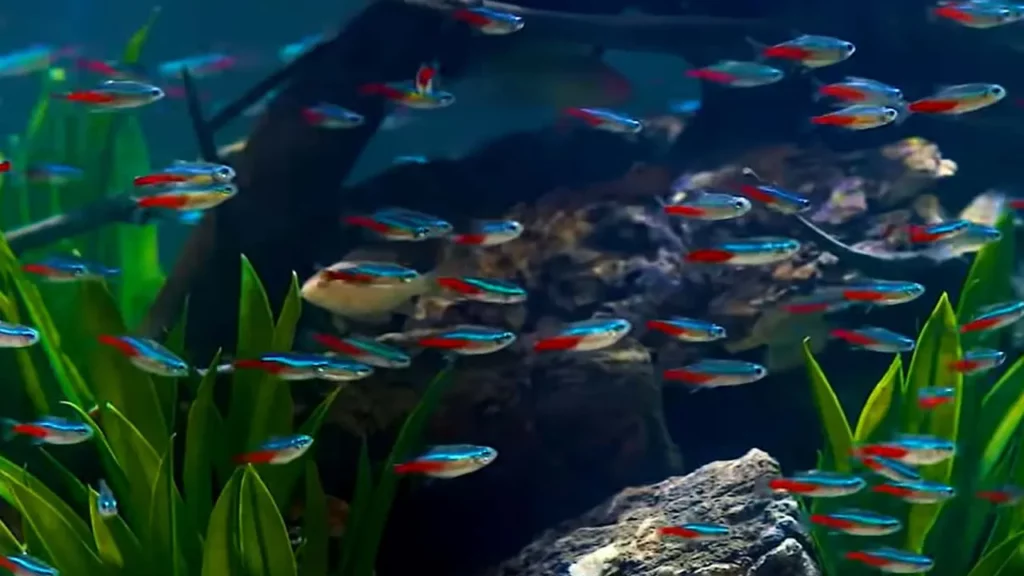
Quarantine New Arrivals
The concept of quarantine, dear reader, might sound a bit clinical, but in the world of aquariums, it’s a gesture of care and foresight.
The Purpose of Quarantine: New fish, no matter how healthy they appear, could potentially carry diseases or parasites. Quarantining serves as a protective buffer, ensuring that any potential health concerns are addressed before introducing the newcomers to the main tank.
Setting Up a Quarantine Tank: This doesn’t require a grand setup. A simple, appropriately-sized tank with a heater, filter, and some hiding places will suffice. Remember, this is a temporary haven, not a permanent residence.
Duration: Typically, a quarantine period of 2-4 weeks is recommended. This window allows for observation, ensuring that the new fish are free from any visible signs of illness or distress.
Treatment, if Needed: If a newcomer shows signs of illness, the quarantine tank becomes a safe place to administer treatments without affecting the established community in the main tank.
The Gentle Transition: Once the quarantine period concludes and the new arrivals appear healthy, they can be introduced to the main tank. Not only does this practice safeguard the health of our original protagonists, but it also provides newcomers with a gentle transition, allowing them to adjust to their new world in stages.
Gradual Introduction
As the curtain rises on this new act, the technique we employ is as significant as the characters themselves. Let’s wade through the nuances of a gentle introduction.
Bag Acclimation: One of the most common methods employed by aquarists worldwide. When new fish arrive, they are often in a bag filled with water from their previous environment.
- Float the Bag: Start by floating the sealed bag in the main tank. This allows the water inside the bag to gradually match the temperature of the aquarium.
- Gradually Mix Water: Over the course of an hour or so, periodically add small amounts of the aquarium water to the bag. This gentle process helps the newcomers adjust to the water parameters of their new home.
- Release with Care: Once acclimated, use a net to gently transfer the fish from the bag to the aquarium. Avoid pouring the bag’s water into the tank to prevent potential contaminants.
Breeder Box Acclimation: This method involves using a breeder box or a similar container.
- Place Newcomers in the Box: Positioned inside the main aquarium, the box allows water to flow through while keeping the fish contained.
- Observe Interactions: As the newcomers swim within the box, it allows both them and the current inhabitants to observe and interact without any physical contact.
- Release When Comfortable: After a few hours or when it seems that all parties are comfortable, the new fish can be released into the main tank.
The Essence of Patience: Regardless of the technique employed, patience is the undercurrent that should guide the process. The world within our aquarium is delicate, and every new addition can shift the balance. By ensuring a slow and careful introduction, we allow all characters in our narrative to adjust, ensuring harmony in the chapters to come.
Observing Interactions
Every fish, be it the playful guppy or the luminescent Neon Tetra, has its own tale to tell, its own emotions to convey. As curators of this aquatic tapestry, our role is to keenly observe these tales, ensuring they blend seamlessly.
First Impressions Matter: Just as in our world, first interactions between fish can set the tone for their future relationship. While guppies and Neon Tetras are generally peaceful, it’s essential to ensure there are no signs of aggression, such as chasing or nipping.
Behavioral Cues: Every flicker of the fin, every subtle change in coloration, and every corner explored can tell a story. Look out for:
- Stress Indicators: Rapid breathing, erratic swimming, or prolonged hiding can be signs of stress.
- Signs of Acceptance: Fish swimming in close proximity without confrontation or even forming schools can be positive indicators.
- Health Check: Ensure there are no visible signs of diseases or parasites. Healthy fish are active, with clear eyes, intact fins, and vibrant colors.
Feeding Dynamics: The dinner table, or in this case, the feeding zone, can be an excellent place to gauge compatibility. Ensure all fish get their fair share and that there isn’t any bullying during feeding times.
Environment Matters: Sometimes, it’s not just about the fish. Ensure that the environment caters to all, with ample hiding spots, open swimming areas, and balanced water parameters.
Intervention, if Needed: While we hope for a harmonious coexistence, sometimes the narrative may require a gentle nudge. If any fish seems perpetually stressed or aggressive, consider rearranging the tank or, if necessary, separating the conflicting characters.
Frequently Asked Questions – FAQ
Give Us Feedback
Please help us get better by making suggestions or giving feedback, we really do listen to it!
